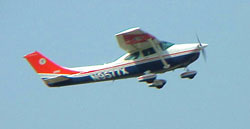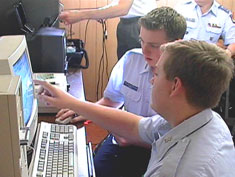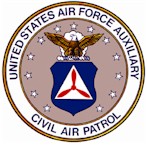|
Growing
from its World War II experience, the Civil Air Patrol has continued
to strive to save lives and alleviate human suffering through a myriad
of emergency service and operational missions.
| Search
and Rescue (SAR): Perhaps best known for its search and
rescue efforts, CAP now flies more than 85 percent of all federal
inland SAR missions directed by the Air Force Rescue Coordination
Center at Langley AFB, Virginia. Outside of the |
 |
continental
United States, CAP supports the Joint Rescue Coordination Centers
in Alaska, Hawaii and Puerto Rico. Just how effective are the CAP
missions? More than 100 people are saved every year by CAP members!
|
 |
Disaster
Relief: Often overlooked but vitally important is the
role CAP plays in disaster relief operations. CAP provides air and
ground transportation, and an extensive communications network.
They fly disaster relief officials to remote locations, and support
local, state and national disaster relief organizations with manpower
and leadership.
|
The
378th Composite SQD maintains a Ground Operations Team that is trained
and ready to respond to both SAR and DR functions. The 378th serves as
one of the CAP-USAF units in the region able to respond to disaster
situations with total logistical support.
|
EMERGENCY SERVICES
CAP is still best known
for its search and rescue missions. Civil Air Patrol air
and ground teams perform 85 percent of inland
search-and-rescue missions for the Air Force's Air Rescue
Coordination Center. These volunteers donate their time
and labor, receiving reimbursement for fuel and oil only,
thus saving the taxpayers millions of dollars. More than
100 lives are saved every year by CAP members on search
and rescue missions!
CAP’s disaster relief missions,
such as those during hurricanes and floods, often don't
make headlines, but CAP provides both air and ground
transportation and an extensive communications network.
CAP members also fly disaster relief officials to remote
locations and support local, state and national disaster
relief organizations with manpower and leadership. CAP
ground teams provide vital assistance to disaster relief
operations.
The CAP Emergency Communications
Network spans the country with a data and voice net built
to survive the loss of civil communications. With one of
the most sophisticated communications networks in the
nation, CAP supports local, state, and federal agencies
during disaster relief, search and rescue and many other
emergencies. The fleet of 530 CAP-owned aircraft
communicates on CAP's own dedicated frequencies, while
new systems coordinate and track search flights via
sophisticated datalink.
The youth-centered CAP Drug Demand
Reduction Program is only one of Civil Air Patrol’s
activities in our country’s "War on
Drugs." Since 1986, CAP has made major contributions
to the counterdrug fight by providing aerial
reconnaissance, airborne communications support, and
airlift of law enforcement personnel. In 1995, CAP units
flew nearly 32,000 hours in support of counterdrug
efforts.
As the official auxiliary of the U.S.
Air Force, it’s not surprising that Civil Air Patrol
performs vital Air Force missions upon request. This
support includes air search and rescue on USAF directed
missions, light transport, communications support and
low-altitude route surveys.
All in all, there are numerous reasons
for enthusiastic, aviation-oriented volunteers to join
one of this country’s premier service organizations.



